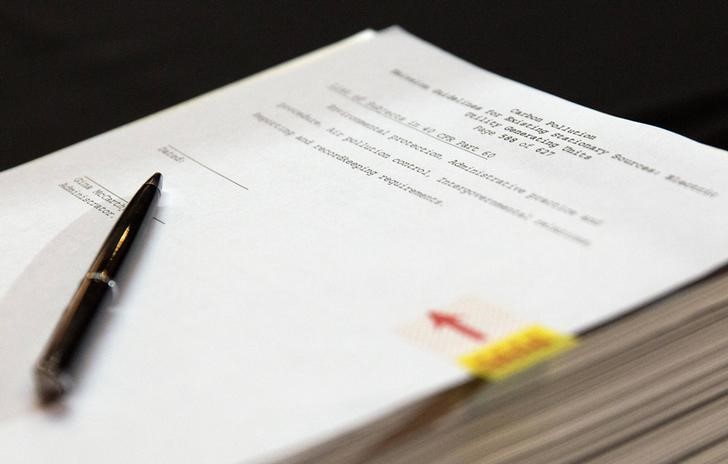By Valerie Volcovici
WASHINGTON (Reuters) - The U.S. Environmental Protection Agency will unveil as soon as Monday the final version of a sweeping - and controversial - regulation to cut carbon emissions from the electricity sector.
In its initial version, the Clean Power Plan called for cutting the country's power plant emissions 30 percent from 2005 levels by 2030, setting different targets for each state.
The proposal is the signature piece of President Barack Obama's climate change policy. White House Chief of Staff Denis McDonough said this week that the final rule will be "stronger in many ways than the proposed rule."
But the Clean Power Plan has been sharply criticized by the energy and manufacturing industries and some energy-producing states, and opponents have already vowed to challenge the regulation in court.
The final rule is expected to accommodate some of that opposition, as well as take into account feedback from over 4.3 million public comments. Among other things: The EPA is expected to push back the rule's start date by two years to 2022, according to a slide posted by the agency briefly on its website on Tuesday.
Here are some things to look for in the final rule:
Why will the EPA push the start date back?
One of the biggest complaints about the draft proposal was the timetable. Some coal-reliant states complained that moving too quickly on building out natural gas pipelines and shutting down coal plants could lead to electricity shortages. And the Edison Electric Institute, a U.S. utility lobby group, said the interim goals would make electricity more costly for consumers. Delaying the start date and giving extra credit to states that took early action offers an "easy concession" for the EPA, according to the Resources for the Future think tank.
Will the EPA change how states can hit their targets?
The EPA set individual goals for each state to reduce the carbon intensity of their power plants based on a mix of four "building blocks": improving efficiency of coal-fired power plants; replacing more coal with natural gas; deploying more wind, solar and hydro power and preserving nuclear power; and expanding consumer energy efficiency programs.
The agency is expected to revise some of their assumptions about how quickly states can switch out coal for natural gas, while taking into account growing penetration of renewable energy sources.
"They will be updating information on renewables and efficiency to incorporate data that wasn't included the first time around," said David Doniger, a director at the Natural Resources Defense Council. "That really ups what you can get out of those sources."
On the other hand, South Carolina, Georgia and Tennessee hope to see less stringent targets in the final rule. Those states have nuclear plants under construction - but not yet operating. The EPA had treated those states as if the plants were already generating power, raising unrealistic expectations for the rate of cuts, those states said.
Will the EPA give states clearer ground rules on interstate emissions trading?
Many experts expect the EPA to make it easier for power plants to trade emission permits as a way to meet their carbon-reduction targets. Allowing states to measure emissions by total tonnage makes it easier for plants to "trade those tons," said Chuck Barlow, head of regulatory affairs at Entergy (NYSE:ETR), a power generator based in New Orleans. Barlow said state air regulators already trade sulfur permits this way. He also expects the EPA to facilitate that emissions trading by dropping requirements for them to strike legal agreements - some of which would require legislative approval - between states.
Will the EPA prepare a federal plan for states that "say no" to the Clean Power Plan?
Senator Mitch McConnell of Kentucky has been urging governors to ignore the EPA rule, though so far only Oklahoma has said it would not comply. The EPA is now expected to reveal a "federal implementation plan" that states would be forced to adopt if they miss a 2016 deadline for submitting plans on how they propose to meet their targets.
